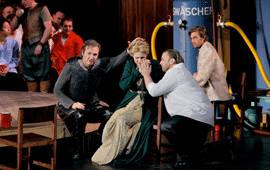> [Archived] Chronicles

Bayreuth Four - Tannhäuser
The decor of the performance that I have seen this summer in Bayreuth is an installation designed by Joep van Lieshout and named Tehnokrat which ensures the production of the elements absolutely necessary to human life. A giant blue machinery produces biogas, i.e. energy, out of recycling every waste, even human waste - Elisabeth will die recycling herself when she willingly enters this machinery. With the help of the regular energy obtained food is prepared which is evenly distributed through a green machinery. Also with the help of biogas alcohol is distilled (red machinery) which, together with excess sex, dominate people's lives. The decor is completed with water reservoirs, beds, work benches and a few small appliances. Venusberg is integrated in the basement of the building that makes up everything. It is a miniature world, a proposition of a possible life style in which man is slave to body cravings of which he cannot get rid very easily. In the first act, during the famous act between Venus and Tannhäuser where the latter insistently asks to be left alone and to go back to the world he came from, four ballet dancers in... spermatozoon costumes throw themselves on him, forcibly trying to make him stay. The same four spermatozoa will return on stage during the last act when, despaired and forever damned, Tannhäuser thinks about returning to Venusberg and to give himself to pleasure again. I don't think the director's intentions can be more explicit than that.
The stage dimensions are huge, with two dizzyingly high bridges. They gave up on the curtain and during the long hour breaks, tens of extras find something to do among the colourful machines. Motion is constant during the three acts and almost non-stop projections which present either strange cellular activity like fertilization, either a supra dimensional image of a suggestion of Madonna with naked breasts, confuses and slows downs the access to music almost to the point of blocking it out.
I do not think anyone has ever pictured Venus... pregnant. The director arguments his vision by stating that a child is also the result of love. They say - and Wagner knew this detail very well - that the Morning Star (Abendstern) is actually the planet Venus. The director uses this information and brings Venus on stage also in the final act and the famous aria of the baritone is totally and evidently dedicated to her.
The child is born during the last tunes of the opera, his life replacing the ones lost with the death of Elisabeth and Tannhäuser. Nothing is further revealed to us about how this life is going to be. Theoretically, the director's vision could have coherency, but in reality, the performance is the only one which left a bitter taste in my mouth and which, I am sure, will still be there even after seeing it for a second time. But maybe then I would have the wisdom to close my eyes and just listen.
Translated by Florina Sãmulescu
MTTLC, Bucharest University














